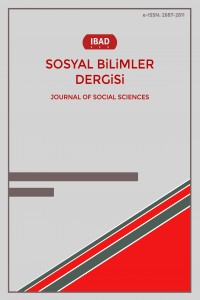Abstract
Günümüzde
değişime bağlı olarak örgüt ve işletmelerde; yönetim biçimleri, iş süreçleri ve
insan kaynağı alanında farklı uygulamalar göze çarpmaktadır. Bu uygulamalar örgüt
ve işletmelerin değişen koşullara ayak uydurabilmesinde ve faaliyetlerini
sürdürebilmesinde düzenleyici rol oynamaktadır. Bu anlayışla geliştirilen esnek
istihdam sistemleri de mavi ve beyaz yakalıların çalışma şeklini düzenleyen uygulamalardır.
Genellikle örgüt ve işletmelerin karşılaştığı kriz dönemlerinde, sorunların
çözümünde ve yeniden yapılanmada tecrübe sahibi kişiler istihdam edilerek bu
sürecin etkin bir şekilde yönetilmesi üst yönetimlerce amaçlanmaktadır. Dolayısıyla,
bu çalışmada, esnek istihdam uygulamalarından biri olan ‘Geçici Yönetim’in
kavramsal açıklaması yapılmış, özellikleri ile örgüt işletmelerinin bu istihdam
şeklini tercih etme nedenleri üzerinde durulmuştur. Bu kapsamda işletmelerin geçici
yöneticilerden beklediği görevler ve geçici yönetim uygulamasının işletmelere
sağladığı maliyet avantajlarından bahsedilmiştir.
References
- Atkinson, J. (1984). Manpower Strategies for Flexible Organisations. In: Personnel Management, 16(8), 28-31.
- Ballinger, G. A. ve Marcel, J. J. (2010). The use of an interim CEO during succession episodes and firm performance. Strategic Management Journal, 31, 262–283.
- Bloemer, V. (2003a). Interim-Management: Top-Kräfte auf Zeit. Berlin.
- Bloemer, V. (2003b). Interim-Management im europäischen Vergleich. Presentation at the German Conference for Interim-Management (Tagung des Deutschen Dachverbandes Interim Manager). Düsseldorf
- Bosch, G. (2004). Towards a new Standard Employment Relationship in Western Europe. In: British Journal of Industrial Relations, 42(4), 617-636.
- Bruns, J. (2006). Interim-management in an innovation context. München/Mering.
- Bruns, J. ve Rüdiger, K. (2005). Interim-Management: A Paradox for leadership Research, Management Revue, Vol.16, Issue 4, 512-524.
- Clutterbuck, D. ve Dearlove, D. (1999). The interim manager: a new career model for the experienced manager. Pitman.
- Chen, G. ve Hambrick, D. C. (2012). CEO replacement in turnaround situations: Executive (mis) fit and its performance implications. Organization Science, 23(1), 225-243.
- Crossland, C. ve Chen, G. (2013). Executive accountability around the world: Sources of cross-national variation in firm performance–CEO dismissal sensitivity. Strategic Organization, 11(1), 78-109.
- Dyer, J. H. (1997). Effective interim collaboration: how firms minimize transaction costs and maximise transaction value. Strategic management journal, 18(7), 535-556.
- Finkelstein, S., Cannella, S. F. B., Hambrick, D. C., & Cannella, A. A. (2009). Strategic leadership: Theory and research on executives, top management teams, and boards. Oxford University Press, USA.
- Goss, D. ve Bridson, J. (1998). Understanding interim management. Human Resource Management Journal, 8(4), 37-50.
- Greiner, L. E. ve Poulfelt, F. (2005). The Contemporary Consultant, Mason/Ohio.
- Inkson, K., Heising, A. ve Rousseau, D. M. (2001). The interim manager: Prototype of the 21st-century worker? In: Human Relations, 53 (3), 259-284.
- Insead, G. C., Luo, S., Tang Y. ve Tong, J. Y. (2015). Passing Probation: Earnings Management by Interim CEO’s and Its Effect on Their Promotion Prospects, Academy of Management Journal, 58 (5), 1389-1418.
- Isidor, R., Schwens, C. ve Kabst, R. (2014). Interim management utilization, firm flexibility and its impact on firm performance. International Journal of Human Resources Development and Management, 14(4), 171-186.
- Kalleberg, A. (2000). Nonstandard Employment Relations: Part-time, Temporary and Contract Work. In: Annual Review of Sociology, (26), 341-365.
- Zhang, Y. ve Rajagopalan, N. (2010). CEO succession planning: Finally at the centerstage of the boardroom. Business Horizons, (53), 455–462.
Abstract
References
- Atkinson, J. (1984). Manpower Strategies for Flexible Organisations. In: Personnel Management, 16(8), 28-31.
- Ballinger, G. A. ve Marcel, J. J. (2010). The use of an interim CEO during succession episodes and firm performance. Strategic Management Journal, 31, 262–283.
- Bloemer, V. (2003a). Interim-Management: Top-Kräfte auf Zeit. Berlin.
- Bloemer, V. (2003b). Interim-Management im europäischen Vergleich. Presentation at the German Conference for Interim-Management (Tagung des Deutschen Dachverbandes Interim Manager). Düsseldorf
- Bosch, G. (2004). Towards a new Standard Employment Relationship in Western Europe. In: British Journal of Industrial Relations, 42(4), 617-636.
- Bruns, J. (2006). Interim-management in an innovation context. München/Mering.
- Bruns, J. ve Rüdiger, K. (2005). Interim-Management: A Paradox for leadership Research, Management Revue, Vol.16, Issue 4, 512-524.
- Clutterbuck, D. ve Dearlove, D. (1999). The interim manager: a new career model for the experienced manager. Pitman.
- Chen, G. ve Hambrick, D. C. (2012). CEO replacement in turnaround situations: Executive (mis) fit and its performance implications. Organization Science, 23(1), 225-243.
- Crossland, C. ve Chen, G. (2013). Executive accountability around the world: Sources of cross-national variation in firm performance–CEO dismissal sensitivity. Strategic Organization, 11(1), 78-109.
- Dyer, J. H. (1997). Effective interim collaboration: how firms minimize transaction costs and maximise transaction value. Strategic management journal, 18(7), 535-556.
- Finkelstein, S., Cannella, S. F. B., Hambrick, D. C., & Cannella, A. A. (2009). Strategic leadership: Theory and research on executives, top management teams, and boards. Oxford University Press, USA.
- Goss, D. ve Bridson, J. (1998). Understanding interim management. Human Resource Management Journal, 8(4), 37-50.
- Greiner, L. E. ve Poulfelt, F. (2005). The Contemporary Consultant, Mason/Ohio.
- Inkson, K., Heising, A. ve Rousseau, D. M. (2001). The interim manager: Prototype of the 21st-century worker? In: Human Relations, 53 (3), 259-284.
- Insead, G. C., Luo, S., Tang Y. ve Tong, J. Y. (2015). Passing Probation: Earnings Management by Interim CEO’s and Its Effect on Their Promotion Prospects, Academy of Management Journal, 58 (5), 1389-1418.
- Isidor, R., Schwens, C. ve Kabst, R. (2014). Interim management utilization, firm flexibility and its impact on firm performance. International Journal of Human Resources Development and Management, 14(4), 171-186.
- Kalleberg, A. (2000). Nonstandard Employment Relations: Part-time, Temporary and Contract Work. In: Annual Review of Sociology, (26), 341-365.
- Zhang, Y. ve Rajagopalan, N. (2010). CEO succession planning: Finally at the centerstage of the boardroom. Business Horizons, (53), 455–462.
Details
| Primary Language | Turkish |
|---|---|
| Journal Section | Research Article |
| Authors | |
| Publication Date | October 30, 2019 |
| Acceptance Date | October 7, 2019 |
| Published in Issue | Year 2019 October 2019 Special Issue |
Ethical Principles & Publication Policy |
This journal is subscribes to the principles of the Committee on Publication Ethics. |
IBAD Journal of Social Sciences I (online) ISSN 2687-2811

